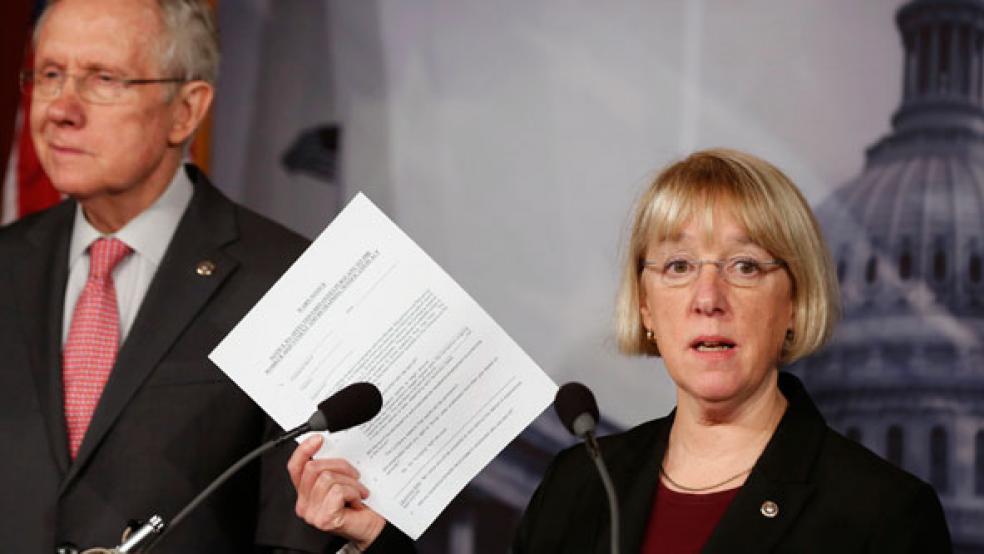The Democrat-controlled Senate approved its first budget blueprint in four years early Saturday, a political milestone that capped months of GOP criticism and set the stage for direct negotiations with the Republican-controlled House.
The Senate blueprint calls for nearly $1 trillion in new taxes over the next decade and only modest reductions in projected government spending. While it would replace sharp, automatic spending cuts known as the sequester, it would do little to alter the nation’s financial outlook, permitting the portion of the national debt held by outside investors to swell from nearly $12 trillion today to more than $18 trillion by 2023.
House Republicans, by contrast, have adopted an anti-tax spending plan that would balance by 2023, leaving the national debt to top out at about $14 trillion. But the House budget, drafted by Rep. Paul Ryan (R-Wis.), calls for a radical reduction in the size of government by curtailing spending on dozens of programs for the poor, repealing President Obama’s health-care law and partially privatizing Medicare for people now younger than 55.
Neither of the budget plans will ever be put into effect. Instead, they set the extreme boundaries as Washington prepares to open a new chapter in the long-running debate over taxes and spending.
In the coming days, Senate leaders plan to request a formal conference on the budget with the House. That would establish Ryan, the former vice-presidential nominee who chairs the House Budget Committee, and Senate Budget Committee Chairman Patty Murray (D-Wash.) as lead negotiators for their respective parties heading into another potential showdown later this summer over the federal debt limit.

Obama has been busily courting Republicans, mostly in the Senate, with the promise that Democrats would back a more moderate path to deficit-reduction that pairs roughly $600 billion in new revenue with nearly $1 trillion in spending cuts, including structural changes to Medicare and Social Security, by far the most expensive federal programs.
On Friday, Murray expressed optimism about the road ahead.
“I realize there are serious differences between the parties, and the last few years have been especially polarized here in Congress,” she said in remarks on the Senate floor. “But the House has now passed its budget resolution, and we will be working here in the Senate to pass ours this evening. We have presented very different visions for how our country should work and who it should work for — but I am hopeful that we can bridge this divide.”
The Senate last approved a budget blueprint in 2009, Obama’s first year in office, when Democrats controlled both the House and Senate. Since then, Senate leaders have chosen to keep the budget bottled up in committee, either to avoid tough votes in an election year or because Democrats could not agree on a plan that included big tax hikes, big deficits or both.
This year, after Obama’s decisive re-election victory, Senate leaders viewed the budget as a vehicle for pressing the popular argument that the wealthy should be asked to pay higher taxes to help reduce persistent budget deficits. The measure passed 50 to 49. Four Democrats -- Sens. Max Baucus (Mont.), Mark Begich (Alaska), Mark Pryor (Ark.) and Kay Hagan (N.C.) -- joined all 45 Republicans in voting no.
Ryan’s budget also won narrow approval in the House, with 10 Republicans joining every Democrat Thursday in voting against no. Ryan, too, pledged to “try to make divided government work.” But he has warned repeatedly that House Republicans will need significant concessions in the form of spending cuts or changes to entitlement programs before they will agree once again to raise the legal limit on government borrowing.
The debt-limit fight is not expected to reach a crescendo until August, and it was a distant worry Friday, as senators prepared to leave town for a two-week Easter break.
Before they could depart, however, senators had to slog through the final stage of the arcane Senate budget process: a marathon of symbolic votes on potential amendments to the budget blueprint known as the “vote-a-rama.”
This year’s vote-a-rama technically began Thursday night, when Democrats forced Senate Republicans to vote on the Ryan budget (rejected 59 to 40, with five Republicans voting no) and Republicans forced Democrats to vote on balancing the budget over the next decade (rejected 53 to 46, with all but one Democrat voting no).
The Senate also overwhelmingly agreed, 79 to 20, that it would be a good idea to repeal an unpopular 2.3 percent tax on medical devices enacted to help finance Obama’s health-care legislation.
On Friday, the Senate went on record, 62 to 37, in support of the Keystone Pipeline, which has been held up by the Obama administration because of environmental concerns. And senators signaled strong support, 75 to 24, for legislation to permit states to require online retailers to collect sales tax on transactions in their states, a move that could end tax-free shopping on the Internet.
Dozens of other amendments, most of them partisan “message” amendments designed to put senators on record on various hot-button issues, pushed the debate past midnight and into the wee hours of Saturday morning. The list was finally exhausted shortly before 5 a.m., and the Senate approved the Murray spending plan, ending what Republicans had complained had been more than 1,400 days without a blueprint.
Sen. Jeff Sessions (Ala.), the senior Republican on the Senate Budget Committee and the most persistent critic of Democrats’ failure to perform their budgetary duties, joked: “At this time -- 5 a.m. -- it is good to say there has not been a single day without a budget being passed in the United States Senate.”

